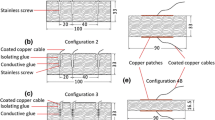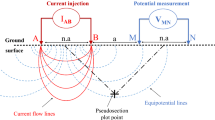Abstract
Today, a strong expansion in the construction of timber bridges is being promoted by the use of glulam. However, durability issues related to wetting/drying cycles limit their development. Timber bridge supervisors have therefore expressed their needs concerning continuous moisture content (MC) monitoring in timber structures. Checks on the MC of timber bridges are commonly based on the resistive method. A recent study carried out in the laboratory has shown the great potential of surface-type electrodes for local MC measurement in the laminated timber of glulam. Nevertheless, many parameters influence MC measurements and no information exists concerning surface electrodes. The novelty of this paper is to make the MC measurements with surface-type electrodes more reliable and accurate. In this study, the influence of electrode size and boundary conditions was therefore investigated. The influence of embedded sensors on the bending strength and elastic modulus of glulam beams was also evaluated in order to validate the electrodes instrumentation. Then, the influence of temperature and MC on the electrical resistance was studied, allowing a calibration curve to be established. The results show that small electrodes reduce the measurement uncertainties and therefore permit a more reliable estimation of MC. The boundary conditions also influence the measurements and should be considered. The embedded electrodes have no significant influence on the bending strength and elastic modulus of glulam beams. Finally, based on the literature review, a model for estimating wood MC was established, considering temperature variation.










Similar content being viewed by others
References
Björngrim N, Hagman O, Wang X (2016) Moisture content monitoring of a timber footbridge. BioResources 11:3904–3913
Björngrim N, Fjellström P-A, Hagman O (2017) Resistance measurements to find high moisture content inclusions adapted for large timber bridge cross-sections. BioResources 12:3570–3582
Brischke C, Rapp AO (2008) Influence of wood moisture content and wood temperature on fungal decay in the field: observations in different micro-climates. Wood Sci Technol 42:663–677
Brischke C, Rapp AO (2010) Service life prediction of wooden components - Part 1: Determination of dose-response functions for above ground decay. In: The International Research Group on Wood Protection, IRG/WP/10-20439, Stockholm
Brischke C, Rapp AO, Bayerbach R (2008) Measurement system for long-term recording of wood moisture content with internal conductively glued electrodes. Build Environ 43:1566–1574
Brischke C, Meyer-Veltrup L, Bornemann T (2017) Moisture performance and durability of wooden façades and decking during six years of outdoor exposure. J Build Eng 13:207–215
Clark JD, Williams JW (1932) The electrical conductivity of commercial dielectrics and its variation with temperature. J Phys Chem 37:119–131
Crocetti R (2016) Large-span timber structures. In: Proceedings of the world congress on civil, structural, and environmental engineering (CSEE’16), Prague, Czech Republic—March 30–31. Paper No. ICSENM 124. https://doi.org/10.11159/icsenm16.124
D’Ayala D, Branco JM, Riggio M et al (2014) Assessment, reinforcement and monitoring of timber structures: FPS Cost Action FP1101. Mexico City, Mexico, pp 1–12
Davidson RW (1958) The effect of temperature on the electrical resistance of wood. For Prod J 8:160–164
Dietsch P, Franke S, Franke B, Gamper A, Winter S (2014a) Methods to determine wood moisture content and their applicability in monitoring concepts. J Civ Struct Health Monit 5:115–127
Dietsch P, Gamper A, Merk M, Winter S (2014b) Monitoring building climate and timber moisture gradient in large-span timber structures. J Civ Struct Health Monit 5:153–165
Elaieb MT (2014) Amélioration de l’imprégnabilité aux solutions aqueuses des duramens des résineux: Le cas du Douglas (Improving the impregnability to the aqueous solutions of resinous heartwood: The case of Douglas Fir) (Pseudotsuga Menziesii Franco). PhD thesis, Université de Lorraine
EN ISO 12571 (2000) Hygrothermal performance of building materials and products -determination of hygroscopic sorption properties
EN 13183-1 (2002) Moisture content of a piece of sawn timber - part 1: determination by oven dry method
EN 13183-2 (2002) Moisture content of a piece of sawn timber - Part 2: Estimation by electrical resistance method
EN 14080 (2013) Timber structures - glued laminated timber and glued solid timber - requirements
EN 408 (2012) Timber structures - structural timber and glued laminated timber—determination of some physical and mechanical properties
Forsén H, Tarvainen V (2000) Accuracy and functionality of hand held wood moisture content meters, vol 420. VTT Publications, Espoo
Fortino S, Hradil P, Genoese A, Genoese A, Pousette A (2019a) Numerical hygro-thermal analysis of coated wooden bridge members exposed to Northern European climates. Constr Build Mater 208:492–505
Fortino S, Hradil P, Metelli G (2019b) Moisture-induced stresses in large glulam beams. Case study: Vihantasalmi Bridge. Wood Mater Sci Eng. https://doi.org/10.1080/17480272.2019.1638828
Franke B, Franke S, Müller A, Vogel M, Scharmacher F, Tannert T (2013) Long term monitoring of timber bridges—assessment and results. Adv Mater Res 778:749–756
Fredriksson M, Wadso L, Johansson P (2013) Small resistive wood moisture sensors: a method for moisture content determination in wood structures. Eur J Wood Prod 71:515–524
Gross H (2013) Glulam handbook. Gross Produktion AB, Stockholm, Sweden
Hansson EF, Brischke C, Meyer L et al (2012) Durability of timber outdoor structures - modelling performance and climate impacts. In: Proceedings of 12th world conference on timber engineering, Auckland
Kabir MF, Daud WM, Khalid K, Sidek HA (1998) Dielectric and ultrasonic properties of rubber wood. Effect of moisture content grain direction and frequency. Holz Roh Werkst 56:223–227
Kasal B (2013) Assessment, reinforcement and monitoring of timber structures - COST FP1101. Adv Mater Res 778:1037–1040
Koch J, Simon A, Arndt RW (2016) Monitoring of moisture content of protected timber bridges. In Proceedings of WCTE 2016 (world conference on timber engineering), Vienna, Austria
Legrand V, TranVan L, Jacquemin F, Casari P (2015) Moisture-uptake induced internal stresses in balsa core sandwich composite plate: modeling and experimental. Compos Struct 119:355–364
Leicher D, Laz T (2014) Usages durables du bois en milieu urbain (sustainable uses of wood in urban areas). Guide of ALEC Plaine Commune (Agence Locale de l’Énergie et du Climat de Plaine Commune), Saint-Denis, France
Li H (2017) Utilisation de matériaux bois intelligents pour la gestion durable des infrastructures (Use of smart wood materials for sustainable infrastructure management). PhD Thesis, Université de Toulouse
Li H, Perrin M, Eyma F, Jacob X, Gibiat V (2018) Moisture content monitoring in glulam structures by embedded sensors via electrical methods. Wood Sci Technol 52:733–752
Moron C, Garcia-Fuentevilla L, Garcia A, Moron A (2016) Measurement of moisture in wood for application in the restoration of old buildings. Sensors 16:697–705
Navi P, Heger F (2005) Comportement thermo-hydromécanique du bois (Thermo-hydromechanical behaviour of wood). PPUR, CH-1015 Lausanne
Nguyen TA, Angellier N, Caré S, Ulmet L, Dubois F (2017) Numerical and experimental approaches to characterize the mass transfer process in wood elements. Wood Sci Technol 51:811–830
Niklewski J, Brischke C, Frühwald Hansson E, Meyer-Veltrup L (2018) Moisture behavior of weathered wood surfaces during cyclic wetting: measurements and modeling. Wood Sci Technol 52:1431–1450
Norberg P (1999) Electrical measurement of moisture content in porous building materials. In: Eighth international conference on durability of building materials and components (8DBMC), 30 May–3 June. Vancouver, Canada, pp 1030–1039
Norberg P (2000) Monitoring wood moisture content using the WETCORR method part 2: calibration and validation. Holz Roh Werkst 58:129–134
Perrin M, Yahyaoui I, Gong X (2019) Acoustic monitoring of timber structures: influence of wood species under bending loading. Constr Build Mater 208:125–134
Pfaff F, Garrahan P (1986) New temperature correction factors for the portable resistance-type moisture meter. For Prod J 36:28–30
Pousette A, Malo K, Thelandersson S, Fortino S, Salokangas L, Wacker J (2017) Durable timber bridges—final report and guidelines, pp 142–149. SP Report 25. Research Institutes of Sweden RISE, Skellefteå, Sweden
Samuelsson A (1992) Calibration curves for resistance-type moisture meters. In 3rd IUFRO international wood drying conference, Vienna, August 18–21
Sell J, Kropf F (1990) Propriétés et caractéristiques des essences de bois (Properties and characteristics of wood species). Lignum, Le Mont
SETRA (2006) Les ponts en bois: comment assurer leur durabilité (Timber bridges: how to ensure their durability). SETRA (Service d’Etudes Technique des Routes et Auto-routes), France. ISBN: 9782110946553
Skaar C (1964) Some factors involved in the electrical determination of moisture gradients in wood. For Prod J 14:239–243
Skaar C (1988) Electrical properties of wood. In: Skaar C (ed) Wood–water relations. Springer, Berlin
Stamm AJ (1927) The electrical resistance of wood as a measure of its moisture content. Ind Eng Chem 19:1021–1025
Tamme V, Muiste P, Kask R et al (2012) Experimental study of electrode effects of resistance type electrodes for monitoring wood drying process above fiber saturation point. For Stud 56:42–55
Tanaka T, Avramidis S, Shida S (2009) Evaluation of moisture content distribution in wood by soft X-ray imaging. J Wood Sci 55:69–73
Vermaas HF (1975) Experimental variables affecting the measurement of the DC resistance of wood. Holzforschung Int J Biol Chem Phys Technol Wood 29:140–144
Zhou M, Caré S, King A, Courtier-Murias D et al (2019) Wetting enhanced by water adsorption in hygroscopic plantlike materials. Phys Rev Res 1:033190
Acknowledgements
This work was funded by the Occitanie Region, Communauté d’Agglomération Tarbes-Lourdes-Pyrénées and the University Institute of Technology of Tarbes. The authors would also like to thank the GEII department (Electrical Engineering and Industrial IT) and, in particular, Emmanuel Laügt for his contribution to the development of the measuring devices. The authors also thank Frédéric Leroy for his help in setting up the tests.
Author information
Authors and Affiliations
Corresponding author
Ethics declarations
Conflict of interest
The authors declare that they have no conflict of interest.
Additional information
Publisher's Note
Springer Nature remains neutral with regard to jurisdictional claims in published maps and institutional affiliations.
Rights and permissions
About this article
Cite this article
Uwizeyimana, P., Perrin, M. & Eyma, F. Moisture monitoring in glulam timber structures with embedded resistive sensors: study of influence parameters. Wood Sci Technol 54, 1463–1478 (2020). https://doi.org/10.1007/s00226-020-01228-8
Received:
Accepted:
Published:
Issue Date:
DOI: https://doi.org/10.1007/s00226-020-01228-8




